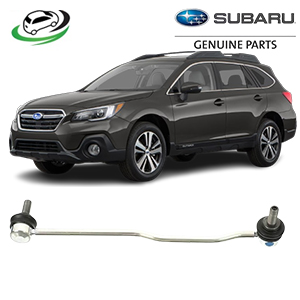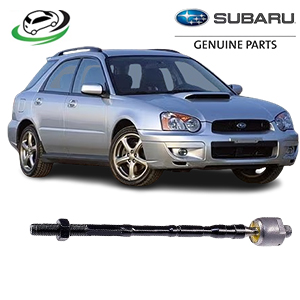-7%
Get Subaru Impreza 2004 Steering Tie Rod End 34160AE000
The steering tie rod end is a critical component in a vehicle’s steering and suspension system. It plays a vital role in connecting the steering rack or steering box to the wheels, enabling smooth and precise steering control. Understanding its functions, benefits, maintenance practices, and replacement procedures is essential for vehicle owners and automotive enthusiasts.
1. What is a Steering Tie Rod End?
A steering tie rod end is a pivotal joint in the steering system that connects the steering gear (either the rack and pinion or the steering box) to the wheel assembly. It typically consists of a metal rod with a threaded end that attaches to the steering gear and a ball joint at the other end that connects to the steering knuckle.
The tie rod end allows for the necessary movement during steering, enabling the wheels to turn in response to the driver’s input while maintaining alignment and stability. Each front wheel has its own tie rod end (often referred to as the inner and outer tie rod ends), working together to control the vehicle’s direction.
2. Functions of the Steering Tie Rod End
The steering tie rod end serves several essential functions within the steering and suspension system:
a. Steering Control
The primary function of the tie rod end is to facilitate steering control. It transmits the rotational motion from the steering wheel to the wheels, allowing the driver to maneuver the vehicle effectively.
b. Maintaining Wheel Alignment
The tie rod end plays a crucial role in maintaining proper wheel alignment. It ensures that the angles of the wheels are correctly set, allowing for even tire wear and optimal handling.
c. Absorbing Road Impacts
The tie rod end helps absorb impacts from the road, providing a buffer between the steering mechanism and the wheels. This function enhances ride comfort and reduces the stress on other steering components.
d. Allowing for Suspension Movement
As the vehicle travels over bumps and uneven surfaces, the tie rod end allows for vertical movement in the suspension while maintaining the connection between the steering gear and the wheels. This flexibility is essential for maintaining traction and stability.
3. Benefits of a Properly Functioning Steering Tie Rod End
A well-functioning steering tie rod end provides numerous benefits for vehicle performance and safety:
a. Improved Steering Responsiveness
A healthy tie rod end ensures precise steering control, allowing the driver to respond quickly to changes in direction. This responsiveness is crucial for safe driving, particularly during evasive maneuvers.
b. Enhanced Vehicle Stability
Properly functioning tie rod ends contribute to vehicle stability. They help keep the wheels aligned and balanced, reducing the risk of drifting or losing control, especially at higher speeds.
c. Extended Tire Life
A well-maintained tie rod end helps ensure that the wheels remain properly aligned. This alignment reduces uneven tire wear, prolonging the lifespan of tires and enhancing fuel efficiency.
d. Better Handling Characteristics
With a functioning tie rod end, the vehicle exhibits improved handling characteristics, making it easier to navigate corners and uneven terrain. This enhanced handling contributes to a more enjoyable driving experience.
e. Increased Safety
By maintaining proper alignment and responsiveness, a healthy tie rod end significantly increases overall vehicle safety. It reduces the risk of accidents caused by steering failures or loss of control.
4. Signs of a Failing Steering Tie Rod End
Recognizing the signs of a failing steering tie rod end is crucial for preventing further damage and maintaining optimal vehicle performance. Common indicators of a worn or damaged tie rod end include:
a. Uneven Tire Wear
If you notice uneven wear on your tires, it may indicate alignment issues related to a failing tie rod end. Proper alignment is crucial for even tire wear.
b. Loose or Wobbly Steering
A loose or wobbly steering feel can be a sign of a failing tie rod end. If the steering wheel feels disconnected or if the vehicle drifts to one side, it’s essential to investigate further.
c. Clunking or Rattling Noises
Clunking or rattling noises when driving over bumps or during steering maneuvers can indicate worn tie rod ends. These noises often signal that the ball joints or bushings are failing.
d. Steering Wheel Vibration
Excessive vibrations in the steering wheel, especially during turns or when driving on rough roads, can be a sign of a failing tie rod end. These vibrations can affect overall driving comfort and control.
e. Visual Inspection
A visual inspection can reveal signs of wear, such as cracks in the rubber boots or excessive play in the ball joint. If you observe any visible damage, it is crucial to address the issue promptly.
5. Maintenance of the Steering Tie Rod End
Regular maintenance of the steering tie rod end is vital for optimal vehicle performance and safety. Key maintenance practices include:
a. Routine Inspections
Conduct regular inspections of the tie rod ends during routine vehicle maintenance. Check for visible wear, looseness, or damage to the tie rod end and its connections.
b. Monitor for Noises and Vibrations
Pay attention to any unusual noises or vibrations coming from the steering system. Early detection of clunking or rattling sounds can help identify potential issues before they worsen.
c. Check for Play in the Tie Rod End
Periodically check for play in the tie rod ends by gently shaking the wheel while the vehicle is lifted. Excessive play may indicate wear and should be addressed promptly.
d. Address Related Suspension Issues
If you notice any signs of wear or failure in the tie rod ends, check for related suspension issues. Addressing any underlying problems can help prevent premature wear of the new components.
e. Seek Professional Assistance
If you are unsure about the condition of your tie rod ends or lack the tools to inspect them, consider seeking professional assistance. A qualified mechanic can assess the tie rod ends and recommend necessary repairs or replacements.
6. Steps to Replace the Steering Tie Rod End
Replacing a steering tie rod end is a relatively straightforward process that can typically be performed with basic tools. Here’s a general outline of the steps involved:
- Gather Necessary Tools
You will need basic hand tools, including a socket set, wrench, and possibly a torque wrench. Have the replacement tie rod end on hand. - Lift the Vehicle
Safely lift the vehicle using a jack and secure it with jack stands to prevent accidental movement. Ensure the vehicle is on a level surface for stability. - Locate the Tie Rod End
Find the tie rod end connected to the steering knuckle. The inner tie rod is connected to the steering gear, while the outer tie rod connects to the steering knuckle. - Remove the Old Tie Rod End
Using the appropriate socket and wrench, remove the nut securing the tie rod end to the steering knuckle. You may need to use a ball joint separator tool if the tie rod end is stubbornly attached. - Inspect Surrounding Components
Before installing the new tie rod end, inspect surrounding suspension components for wear or damage. Address any issues before proceeding with the replacement. - Install the New Tie Rod End
Position the new tie rod end in place, aligning it with the steering knuckle. Secure it with the nut, ensuring it is tightened to the manufacturer’s specifications. - Adjust Alignment
Once the new tie rod end is installed, it is essential to have the vehicle’s alignment checked and adjusted. Proper alignment ensures optimal handling and tire wear. - Lower the Vehicle
Carefully lower the vehicle back to the ground and remove the jack stands. Ensure everything is properly secured before driving. - Test Drive the Vehicle
After the replacement, take the vehicle for a test drive. Pay attention to the handling, ride quality, and any noises coming from the steering area to ensure everything is functioning correctly.
Conclusion
The steering tie rod end is a vital component of a vehicle’s steering and suspension system, playing a crucial role in maintaining stability, handling, and ride quality. Understanding its functions, benefits, maintenance practices, and signs of wear can help vehicle owners take proactive steps to ensure their steering systems remain in optimal condition. Regular inspections and timely replacements of tie rod ends contribute to improved vehicle performance, enhanced safety, and a more enjoyable driving experience. By keeping this essential component well-maintained, drivers can enjoy a smoother ride and greater peace of mind on the road.
Follow us on Facebook for more parts.




Reviews
Clear filtersThere are no reviews yet.